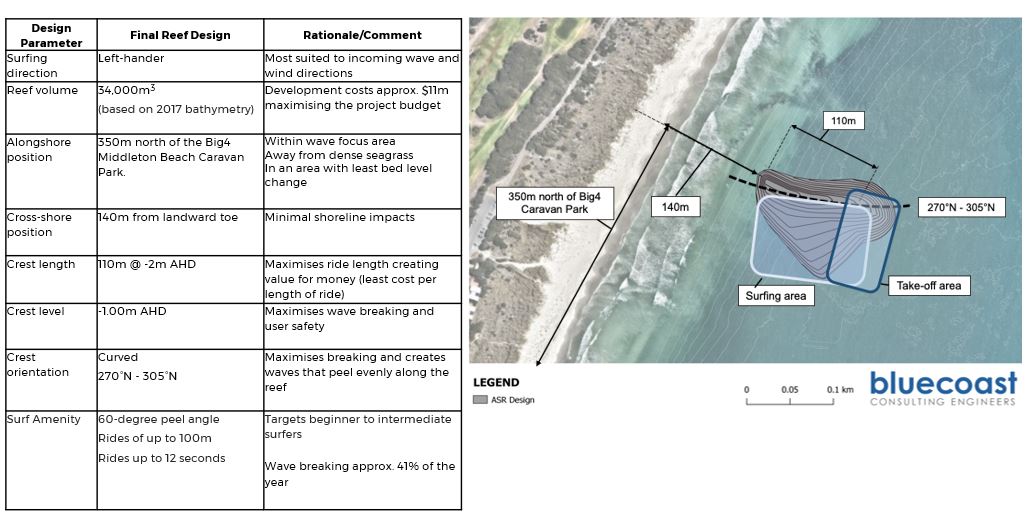Southern Ocean Surf Reef
The Albany community have been advocating for an artificial surf reef for nearly two decades. Prior to City involvement, a series of comprehensive reports were undertaken by advocacy groups in relation to the creation of an artificial surf reef in Albany.
A Steering Group was established by the City who commissioned an updated Feasibility Study for an artificial surf reef at Middleton Beach. The study was completed in July 2015 DHV with the primary objective being to deliver:
“The creation of a consistent, surfable wave, which maximises available swell conditions and is central to Albany, driving benefits in tourism, economic development and retention of Albany’s younger age demographic"
Business Case Summary
The costs in the analysis include the capital costs for the project, phased in line with the plan. Benefits explored in the analysis include:
- An uplift in event visitation associated with committed Albany Boardrider and Surfing WA events (~10 per annum);
- An uplift in overnight tourism, a conservative estimate of around 3,500 people per annum
- Indirect visitor spend benefits through the ‘ripple’ effect.
- The calculations demonstrate a positive Net Present Value (NPV) of $57.9 million and
- Benefit-Cost Ratio (BCR) of 6.69.The results remain strong even if only event benefits are calculated, without visitor uplift
- Hosting surfing events to increase tourism.
- Drawcard as a tourist destination - general uplift in visitation and length of stay expected.
- Complementing Investment:
- Supporting Albany's position as the Adventure Capital of Western Australia.
- Enhancing private and public developments from Emu Point to Middleton Beach.
- Boosting the Middleton Beach Activity Centre and recently completed foreshore enhancements.
- Long-term sustainable infrastructure investment that will benefit the environment.
- Attract and retain the younger demographic.
- Aligning with tertiary educational opportunities, especially at UWA Albany and student housing, including marine science and ecological courses.
- Establishing Albany as a recognized outdoor recreation and surfing hub.
- Substantial economic and social benefits from increased participation.
- Improved safety through increased monitoring and less travel.
Design Aspects:
The detailed design outcomes concluded that:
- The proposed SOSR will consist of a submerged rock reef structure, the design of which has resulted from an iterative process involving thorough numerical, physical and conceptual modelling.
- All aspects of the SOSR design were considered in modelling, including its location, footprint and shape.
- The location has been optimised based on existing seabed variability, user accessibility, shoreline response, wave climate and local ecology.
- The shape has been optimised to improve wave breaking characteristics, promote user safety, minimise coastal impacts and reduce construction costs.
- The design provides a ‘left-hander’ surfing wave, situated 150m north of the ‘Surfer’s Beach’ car park and approximately 140m offshore. The reef measures 165m long and varies in width up to 110m. At its shallowest point, the crest of the reef will be 1m below average water level to maximise wave breaking whilst also ensuring adequate user safety.
- The design provides surfing rides of up to 100m during average conditions, with surfable waves expected for 41 per cent of the year over the reef, with further surfing opportunities inshore of the structure.
- The reef is made up of layered rock structure comprising quarry run belly, core rock layer and protective armour rock (sizes as shown below)
- The SOSR has a relatively large footprint with mild seaward slopes and a broad 3D shape.
- Shallowest crest level of -1.0m AHD which is approximately 0.74m below mean low water (MLLW) and 1.34m below mean high water (MHHW).
- The rock structure is to be constructed to relatively tight tolerances, which vary across the structure’s footprint as outlined below.
- The structure is designed to be low maintenance (with physical modelling tests simulating storm event conditions to prove structure stability and performance), with low maintenance requirements associated with inspection and monitoring.
| Reef Volume |
62,800 t |
| Belly D50 0.16m |
12,400 t (18%) |
| Core D50 0.49m |
23,600 t (36%) |
| Class 1 Armour D50 0.94m |
26,800 t (46%) |
|
|

| Project Team |
| Project Principal: |
City of Albany |
| Main Contractor: |
Heron Construction Limited |
| Design Consultants: |
Bluecoast Consulting Engineers |
| Project Superintendent: |
Stantec |
Programme
Quarry site establishment and rock production
Spinifex Crushing and Screening Services (Martin Shuttleworth) Mindijup Rd. Palmdale
Oct 24 – Feb 25
Status: 30% complete
Delivery of rock from quarry to port
Jan 25 – Feb 25
Status: first delivery expected mid-Jan
Establishment of Material Loading Facility (MLF) at Port
Dec 24- Jan 25
Status: awaiting approval from Southern Ports
Marine plant mobilisation (from Darwin)
Nov 24
Heron’s Machiavalli backhoe dredge has arrived early from Darwin and currently secured and parked in Berth 4 at the Port. This is the main plant that will be used to construct the actual reef in March 2025.
Marine plant mobilisation (from Adelaide)
Jan 25
This will include a Messenger flat topped spudded barge (for mooring at the MLF), split hopper barges, material handling machine, towing tugs and survey craft
Construction period (loading of rock onto barges and placement onto seabed floor)
Jan – Mar 25
Surveys and practical completion
Mar 25
| Funding Sponsors |
| Total Committed Funds |
$11,750,000 |
| Commonwealth Government |
$4.75 million |
| Government of Western Australia (DPIRD) |
$5 million |
| City of Albany |
$1.995 million |
| Albany Boardriders |
$ 5,000 |